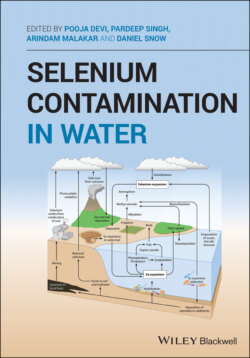Читать книгу Selenium Contamination in Water - Группа авторов - Страница 33
3.1.1 Chemistry of Se
ОглавлениеSe is a metalloid with atomic number 34 and molecular mass of 78.971 g/mol, which means it is heavier than Fe, Ni, and Mn, and lighter than Ag, Pb, and Au. In the periodic table it occurs in fourth period and belongs to the XVI (chalcogen) group. Se occurs in different allotropic forms such as amorphous, crystalline, and metallic which varies its physical properties. The two distinct allotropes of amorphous Se are finely divided brick red form and vitreous form. The only difference between these two allotropes is the route of production; otherwise at microscopic level they appear alike. The crystalline allotropes appear in various monoclinic varieties such as red to brown in color and metallic gray or black Se. Both monoclinic and amorphous forms of Se converts spontaneously at 70–120 °C, whereas the hexagonal crystalline allotrope is thermodynamically most stable at temperatures above 110 °C. Se exists in different oxidation states due to its strong metallic properties. It can be reduced to the selenide (Se−2) oxidation state or oxidized to the +4, i.e. selenite (SeO32−) or +6, i.e. selenate (SeO42−) oxidation states (Fernández‐Martínez and Charlet 2009).
It is a trace element with five stable isotopes 74Se, 76Se, 77Se, 78Se, 80Se reported till date, based on half‐life ranging from 20 ms to 295 000 years whereas 24 unstable Se isotopes are present in nature (Aston 1922). The nuclear waste disposal research has drawn attention toward the fission product of 235U which has the isotope of Se as 79Se. 82Se has a very long half‐life of approximately 1020 years, hence it is considered as the stable isotope which yields 80Kr through double beta decay.
Se shows similar chemical behavior to sulfur and similar physiological properties to arsenic. The valance electronic configuration of Se ([Ar] 3d10 4s2 4p4) is similar to that of sulfur and shows that the properties such as size of atom both in ionic and covalent states, electronegativity, ionization potential, and bond energies are similar to that of sulfur, but in biological systems where sulfur tends to reduce, Se tends to oxidize (Wessjohann et al. 2007).
